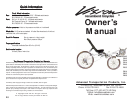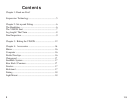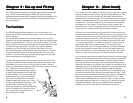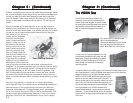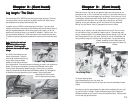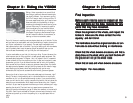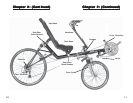
6
Your VISION dealer will have put your recumbent together and set the adjustments
for you. We don't recommend riding your VISION at all until the following
procedures have been accomplished or checked by a qualified bicycle mechanic. We
will review the fitting instructions here, and also point out some areas that need
continuing inspection.
The HandlebarThe Handlebar
The HandlebarThe Handlebar
The Handlebar
Your VISION handlebar has been installed on your bike at the factory, but
removed from the steerer (over-seat steering style) or the fork stem (below-seat
style) for shipment.
For over-seat steering models, insert the lower handlebar stem into the fork
completely, align the stem plates parallel to the front wheel, and tighten the stem
bolt to a torque specification of 65 in-lbs. Next, adjust the height of the bar at
the sliding section. When you are comfortable with the height, make sure at least
3 inches of the lower riser are still in the upper riser, align the handlebars
perpendicular to the front wheel, and tighten the riser clamp to 65 in-lbs.
The above bar handlebar rotates forward for ease of entry and exit - it is meant
to be pulled back tight against the fore/aft rest adjustment bolt under riding
conditions. Set the bolt such that your elbows just rest against the seat sides
when the handlebars are pulled against the stop.
For below-seat steering models, insert the stem all the way into the fork tube,
then back out the stem at least one quarter inch to prevent interference. Level
the handlebar by sitting on the bike, turning the bars from side to side, and
checking for seat/handlebar interference. Tighten the stem bolt and/or the binder
bolt. Adjust the fore and aft position of the
handlebars so that the handlebar grip is parallel
or angled slightly downward from the seat frame.
To check alignment, sit on the seat, grasp both
handlebar grips firmly, and turn the handlebar
side to side - there should be no interference
between the seat frame and your arms. If there
is, rotate the grips rearward in the stem. Tighten
the stem binder. The bars should be tight
enough that they will not rotate with 60lbs/27kg
force on the handle, but not so tight that they
will not rotate under a sharp blow (such as
laying the bicycle on its side).
Chapter 2: Set-up and FittingChapter 2: Set-up and Fitting
Chapter 2: Set-up and FittingChapter 2: Set-up and Fitting
Chapter 2: Set-up and Fitting
15
line—and are sure you’re not about to take a long ride on a short pier—practice
swinging your head to the left and right, taking quick glances behind you. The
first time you do this you will inevitably shift your weight and hand position,
causing the bike to swerve. Don’t panic, this is why we are practicing in the park
instead of a congested street. While many riders like to use a helmet or bicycle
mounted mirror—and we sell a beautiful unit that mounts onto the handlebar,
see Chapter four of this manual—it’s important to be able to actually look
around behind you. This not only gives you options on checking out traffic, but
practicing this will increase your skills and confidence on the bike.
At this point you should be feeling pretty good about life, zooming along nice
and comfortable, relaxed and thinking about how much fun you are going to have
on this thing. Well don’t get too cocky yet. Before you hit the open road there are
a some more exercises you should do. Practice circling, both to the right and to
the left. Start out with gentle curves, and progress to tighter and tighter radius
“U” turns. You should really try to master turning slowly in as tight a curve as
possible quite a few times, this gets you ready for the real world of poor
directions and detours. If you find yourself wobbling or jerking the handlebars
around, you are probably too tense. Relax, let your hands grasp the bars in a
light but firm manner. Let your shoulders droop, relax your neck, don’t “death-
clench” your teeth. Once you relax you will have more control over the bike.
Next, you should practice using the brakes. Stop and take off a few times, getting
a feel for how much pressure on the lever it takes to slow down or stop the bike.
Remember to always use both brakes together, with gentle pressure at first to
stop the bike smoothly. Drop both your feet to the pavement while giving the
brakes the final squeeze to stop the bike. Lean forward a bit and stand up, while
reaching behind you for the seat frame to steady the bike. Practice stopping and
dismounting, then starting off again. You should also practice stopping by
dropping only one leg, typically your non-dominant leg. This exercise will help
you deal with momentary stops, such as at stop signs and traffic lights. It does
take a little practice to balance the bike leaning onto a single leg. Remember to
keep one hand clamped on a brake to prevent the bike from rolling, it really
helps. I usually immediately cock my “crank-bound” leg for the start, and then
hold pressure against the brake until I’m ready to go. You should also carefully
investigate what happens to the bike with gradually increasing brake lever
pressure, so you will be comfortable with quick decisions on the road.
Chapter 3: (Continued)Chapter 3: (Continued)
Chapter 3: (Continued)Chapter 3: (Continued)
Chapter 3: (Continued)



